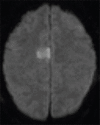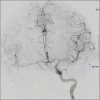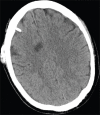Subarachnoid Hemorrhage and Internal Carotid Artery Dissection and Occlusion Following Self-Enucleation
- PMID: 33708688
- PMCID: PMC7869289
- DOI: 10.4103/ajns.AJNS_183_20
Subarachnoid Hemorrhage and Internal Carotid Artery Dissection and Occlusion Following Self-Enucleation
Abstract
Self-enucleation is an uncommon type of major self-injury, which may lead to severe neurological deficits and life-threatening complications, such as subarachnoid hemorrhage (SAH) and internal carotid artery (ICA) dissection and occlusion. Our patient is a 53-year-old man with a history of bipolar disorder and schizophrenia who presented with SAH, intraventricular hemorrhage, ICA dissection and occlusion, and right cerebral infarct following self-enucleation. Despite a Glasgow Coma Score of 6 on initial presentation, he improved with conservative management. He achieved a near-complete neurological recovery, with residual left lower extremity weakness and mild confusion. Self-enucleation is a major neurologic, ophthalmologic, and psychiatric emergency with a potential for serious neurological complications and contralateral visual loss. Yet, conservative management may lead to dramatic recovery.
Keywords: Dissection; internal carotid artery; occlusion; self-enucleation; subarachnoid hemorrhage.
Copyright: © 2020 Asian Journal of Neurosurgery.
Conflict of interest statement
There are no conflicts of interest.
Figures





Similar articles
-
[Spontaneous intracranial internal carotid artery dissection: 6 case reports and a review of 39 cases in the literature].Rinsho Shinkeigaku. 2003 Jun;43(6):313-21. Rinsho Shinkeigaku. 2003. PMID: 14503348 Review. Japanese.
-
Upper cranial nerve palsy resulting from spontaneous carotid dissection.J Neurol. 2005 Apr;252(4):453-6. doi: 10.1007/s00415-005-0673-7. Epub 2005 Mar 4. J Neurol. 2005. PMID: 15739041
-
Fatal subarachnoid hemorrhage associated with internal carotid artery dissection resulting from whiplash trauma.Forensic Sci Med Pathol. 2015 Dec;11(4):564-9. doi: 10.1007/s12024-015-9715-3. Epub 2015 Oct 24. Forensic Sci Med Pathol. 2015. PMID: 26499790
-
Extracranial-Intracranial High-Flow Bypass for Giant Ruptured Paraclinoid Aneurysm with Concomitant Bilateral Internal Carotid Artery Stenotic Dissection.World Neurosurg. 2018 Sep;117:265-270. doi: 10.1016/j.wneu.2018.06.101. Epub 2018 Jun 21. World Neurosurg. 2018. PMID: 29936212
-
Spontaneous intracranial internal carotid artery dissection: report of 10 patients.Arch Neurol. 2002 Jun;59(6):977-81. doi: 10.1001/archneur.59.6.977. Arch Neurol. 2002. PMID: 12056934 Review.
Cited by
-
Traumatic Bilateral Self-Enucleation With Subarachnoid Hemorrhage.Am Surg. 2023 Nov;89(11):4905-4907. doi: 10.1177/00031348211041565. Epub 2021 Aug 30. Am Surg. 2023. PMID: 34459279 Free PMC article.
References
-
- Davis LE, Tripathi S. A case of self-enucleation in an incarcerated patient: Case report and review of literature. J Forensic Sci. 2018;63:1908–10. - PubMed
-
- Patton N. Self-inflicted eye injuries: A review. Eye (Lond) 2004;18:867–72. - PubMed
-
- Gauger EH, Sobel RK, Allen RC. Complications and outcomes after autoenucleation. Curr Opin Ophthalmol. 2015;26:429–38. - PubMed
-
- Kotlus BS, Lo MW. Subarachnoid hemorrhage and vasospastic stroke after self-enucleation. Ophthalmic Plast Reconstr Surg. 2007;23:425–7. - PubMed
Publication types
LinkOut - more resources
Full Text Sources
Miscellaneous

